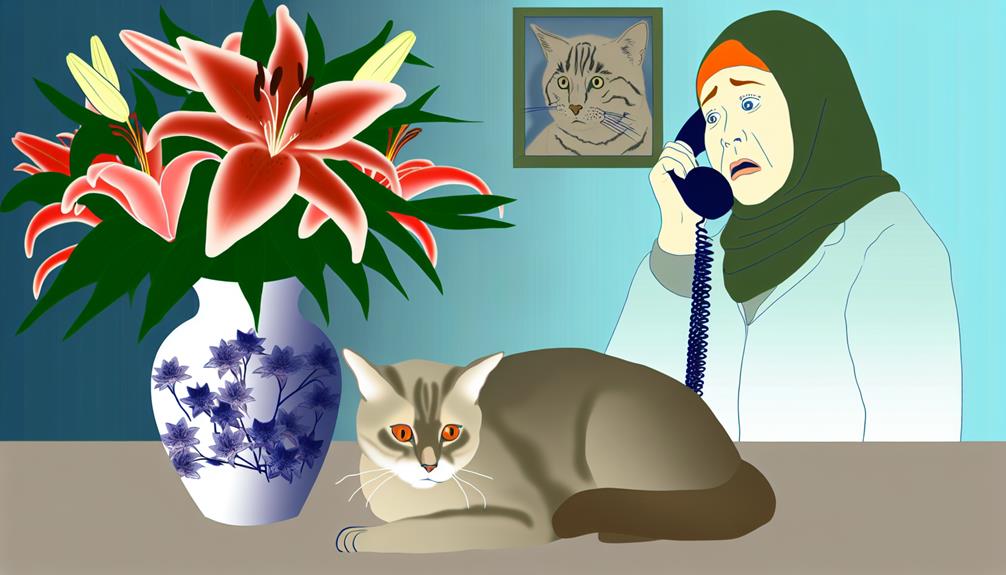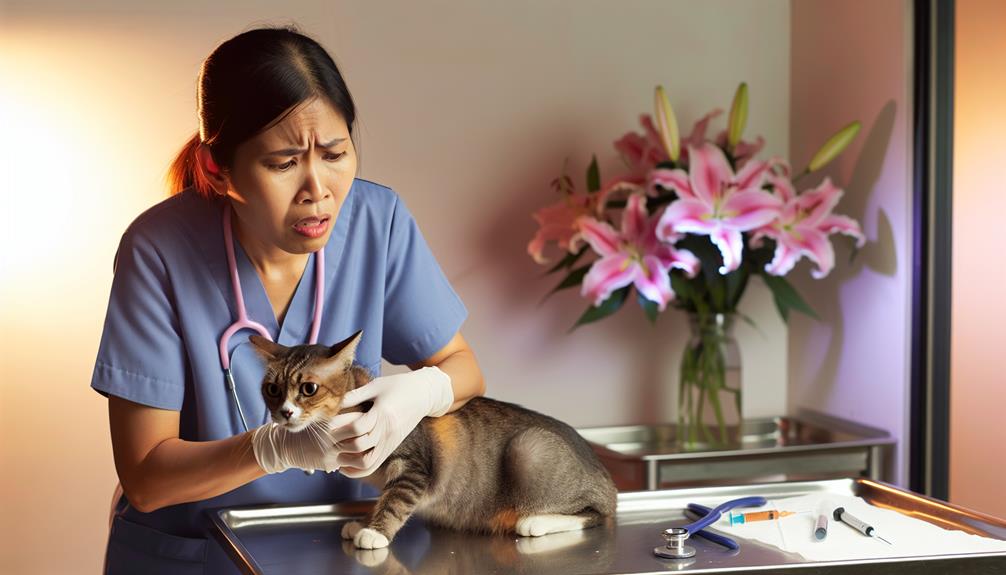You might be surprised to learn that lilies, those beautiful and fragrant flowers, are highly toxic to cats, especially varieties like Easter, Tiger, and Stargazer lilies. Even a small amount of exposure, such as licking pollen off their fur, can lead to severe health issues, including acute kidney failure. It's essential to recognize the symptoms, which can escalate quickly from vomiting and lethargy to more severe complications. So, what should you do if your cat comes into contact with a lily? Understanding the necessary steps could make all the difference.
Types of Toxic Lilies
When considering the types of toxic lilies, it's important to recognize that not all lilies pose the same risk to cats. Understanding the specific types of lilies and their characteristics can help you identify which are the most dangerous.
Firstly, true lilies, belonging to the genus *Lilium*, are among the most hazardous. This group includes Easter lilies (*Lilium longiflorum*), tiger lilies (*Lilium lancifolium*), and stargazer lilies (*Lilium orientalis*). These lilies are known for their large, fragrant flowers and prominent stamens. Every part of the plant, from the petals to the pollen, poses a significant threat.
Daylilies (*Hemerocallis* spp.), although not true lilies, exhibit similar toxic characteristics. These plants are commonly found in gardens and feature trumpet-shaped flowers. Even small amounts ingested can lead to severe clinical signs in felines.
It's vital to differentiate these from other lily-like plants that don't carry the same risk. For instance, the peace lily (*Spathiphyllum* spp.) and the calla lily (*Zantedeschia* spp.) are often mistaken for true lilies due to their similar appearance. However, these belong to different botanical families and primarily cause mild gastrointestinal distress rather than severe systemic toxicity.
Why Lilies Are Dangerous
Understanding the types of toxic lilies underscores the importance of recognizing why these plants are particularly dangerous to cats. Lilies are not just beautiful; they are also potent sources of toxins that can lead to severe renal failure in felines. The primary peril lies in the rapid absorption of toxins from lily varieties such as Easter lilies, Tiger lilies, and Daylilies. Even minimal exposure, like ingesting pollen or licking water from a vase containing lilies, can be fatal for your cat.
One significant factor is cat behavior. Cats are naturally curious and tend to explore their environment with their mouths, making them particularly vulnerable to toxic plants. Unlike dogs, cats have a unique metabolism that makes them more susceptible to certain toxins. The exact toxin in lilies that causes renal failure remains unidentified, but its effects are well-documented and can be catastrophic.
Here's a detailed breakdown of why specific lily varieties pose such a risk:
| Lily Variety | Toxic Component | Impact on Cats |
|---|---|---|
| Easter Lily | Unknown | Acute renal failure |
| Tiger Lily | Unknown | Severe kidney damage |
| Daylily | Unknown | Rapid onset of toxicity |
| Asiatic Lily | Unknown | Elevated levels of creatinine |
| Japanese Show Lily | Unknown | Compromised renal function |
Understanding why lilies are dangerous is essential for any cat owner. Cats' grooming habits mean they can ingest toxic materials just by cleaning their fur after brushing against a lily. Early intervention is key, but prevention remains the best strategy. By keeping lilies out of your home, you can protect your feline friend from these potentially lethal plants.
Symptoms of Poisoning

If your cat ingests any part of a lily plant, you may notice symptoms like vomiting, lethargy, and loss of appetite. These signs indicate acute kidney injury, which can progress rapidly without immediate veterinary intervention. It's essential to seek emergency care as untreated poisoning can be fatal within a few days.
Common Poisoning Symptoms
Symptoms of poisoning in cats that have ingested lilies can manifest rapidly and are often severe. It's essential for you to engage in symptom recognition as early intervention can make a significant difference. You'll notice changes in feline behavior, such as lethargy or unusual hiding. Gastrointestinal symptoms like vomiting and loss of appetite are common initial signs.
Here's a concise table summarizing common symptoms:
| Symptom | Description |
|---|---|
| Vomiting | Frequent, often with plant debris |
| Lethargy | Unusual tiredness, lack of activity |
| Anorexia | Refusal to eat, sudden weight loss |
Renal symptoms are particularly concerning. Acute kidney injury can develop within 24-72 hours, characterized by increased thirst and urination initially, followed by anuria (complete lack of urine production).
| Symptom | Description |
|---|---|
| Polyuria | Increased urination, excessive thirst |
| Anuria | Complete cessation of urine output |
Neurological symptoms may also appear as the condition progresses, including tremors and seizures, which indicate severe toxicity. Observing these signs warrants immediate attention. Always remember, your prompt action and awareness can save your cat's life.
Emergency Veterinary Care
Recognizing the rapid onset and severity of symptoms associated with lily poisoning, immediate veterinary intervention is paramount. Lilies can induce acute renal failure in cats, with clinical signs manifesting within hours. Early symptoms include vomiting, lethargy, and anorexia. As the condition progresses, you may observe polyuria (excessive urination) or anuria (absence of urination), both indicative of kidney dysfunction.
An effective emergency response involves swift transportation to a veterinary clinic. Specialized veterinary resources, such as intravenous fluids and renal function monitoring, are critical for stabilizing the cat. Activated charcoal may be administered to limit toxin absorption if ingestion occurred within the past few hours. Blood tests will ascertain the extent of renal impairment, guiding further treatment.
Time is of the essence; delaying care can result in irreversible kidney damage or death. If you suspect lily poisoning, contact your veterinarian immediately. They may advise inducing vomiting at home using hydrogen peroxide, but only under professional guidance. Remember, prompt intervention can greatly improve your cat's prognosis. Knowledge about nearby emergency veterinary services can be lifesaving, ensuring you're prepared for such critical situations.
Immediate Actions to Take
When your cat has been exposed to lilies, prompt intervention is essential to guarantee their safety. Immediate actions can greatly influence the prognosis, so it's important to remain calm yet act swiftly.
First, if you observe any abnormal cat behavior such as vomiting, lethargy, or decreased appetite, it's crucial to respond immediately. These symptoms may indicate toxic exposure. Quickly remove any plant material from their vicinity to enhance plant safety and minimize further ingestion risks.
Next, you should rinse your cat's mouth with water if you suspect ingestion of any lily parts. While this won't neutralize the toxins, it can help remove residual plant matter. Be cautious, as some cats might resist; forcing them can cause stress and potential injury.
Gather information about the specific type of lily your cat came into contact with, as some species are more toxic than others. This information will be important for the veterinary team to tailor the most effective intervention strategy.
It's also necessary to collect any vomit samples or plant parts your cat may have chewed on. These samples can provide crucial information for diagnosing the extent of exposure and guiding treatment.
Finally, contact your veterinarian immediately. Inform them of the situation and provide details about your cat's behavior and the type of lily involved. They may advise you to bring your cat in for immediate evaluation or suggest interim steps to stabilize your pet.
Taking these immediate actions can make a considerable difference in your cat's recovery, emphasizing the importance of vigilance and prompt response when it comes to plant safety and toxic exposures.
Veterinary Treatment Options

When your cat is exposed to lilies, immediate veterinary intervention is essential to prevent acute kidney failure. The treatment protocol typically includes intravenous fluid therapy and medications to support renal function. For long-term care, your veterinarian may recommend regular monitoring of kidney parameters and dietary adjustments to manage any residual renal impairment.
Immediate Medical Response
Immediate medical intervention is vital when a cat is suspected of ingesting any part of a lily plant, given the high toxicity these plants pose to felines. Swift action can considerably improve the prognosis. Your first step is to follow emergency protocols: contact your veterinarian or an emergency animal clinic immediately. They'll guide you through initial first aid procedures, which may include inducing vomiting if the ingestion occurred within the last hour.
Upon arrival at the veterinary clinic, several important steps will be initiated:
- Decontamination: Activated charcoal may be administered to limit further absorption of toxins in the gastrointestinal tract.
- Intravenous Fluids (IVF): These are vital to support renal function and prevent acute kidney failure, a common consequence of lily poisoning.
- Blood Tests: Baseline and periodic blood work are necessary to monitor kidney function and electrolytes.
- Supportive Care: This might include medications for nausea, pain management, and other symptomatic treatments.
Time is of the essence. The sooner your cat receives professional care, the better the likelihood of a full recovery. Remember, lily poisoning can be fatal, but with prompt and appropriate veterinary intervention, your cat's chances of survival are markedly enhanced.
Long-term Care Plans
After the initial emergency treatment, it's crucial to develop a thorough long-term care plan to guarantee your cat's full recovery from lily poisoning. Long-term health management involves regular veterinary check-ups, tailored dietary adjustments, and medication to support renal function. Your vet will likely recommend follow-up blood tests to monitor kidney health, ensuring early detection of any lingering issues.
Incorporating holistic approaches can also be beneficial. These may include specialized kidney support diets, hydration therapy, and possibly supplements like omega-3 fatty acids, which are known to support renal health. Always consult your vet before adding any new treatments to your cat's regimen.
| Aspect of Care | Recommended Actions | Frequency |
|---|---|---|
| Veterinary Check-ups | Blood tests, physical exams | Every 3-6 months |
| Dietary Adjustments | Kidney support diets, hydration | Daily |
| Supplements | Omega-3 fatty acids, renal support | As prescribed |
Consistent monitoring and adjustments to your cat's care plan are crucial. With both conventional and holistic strategies, you'll enhance your cat's quality of life and mitigate the long-term effects of lily toxicity. Remember, proactive care is the cornerstone of long-term health in your feline friend.
Preventing Lily Poisoning
Ensuring the safety of your feline companions involves taking proactive steps to prevent lily poisoning, which is a well-documented hazard. Cats are highly sensitive to the toxic compounds found in lilies, and even minimal exposure can result in acute kidney failure. Here's how you can effectively mitigate this risk:
- Eliminate Lilies from Your Home and Garden: The most straightforward approach to cat safety is to remove all lilies from your living spaces. This includes popular varieties like Easter lilies, Tiger lilies, and Day lilies.
- Opt for Lily Alternatives: Consider replacing lilies with non-toxic plants. Examples include roses, orchids, and sunflowers, which are safe for feline exposure. These lily alternatives provide similar aesthetic appeal without endangering your pet's health.
- Educate Household Members: Make sure everyone in the household is aware of the dangers lilies pose to cats. This includes informing guests and caregivers, ensuring they don't bring lilies into your home or inadvertently expose your cat.
- Regular Veterinary Check-ups: Routine veterinary visits can help catch any early signs of poisoning. If you suspect your cat may have been exposed to lilies, immediate medical intervention can greatly improve outcomes.
These precautionary measures are grounded in clinical evidence and expert recommendations. Studies have consistently shown that lily poisoning is one of the leading causes of feline kidney failure. By adopting these strategies, you'll not only enhance cat safety but also reduce the likelihood of an emergency veterinary visit. Remember, when it comes to safeguarding your cat's health, a proactive approach is always more effective than reactive measures.
Conclusion
In the blink of an eye, a single lily petal can transform your cat's playground into a perilous minefield. Don't gamble with fate—remove these toxic temptations and educate everyone in your home. If you suspect lily poisoning, act swiftly; time is kidney tissue. Veterinary intervention can be a lifeline, making the difference between recovery and irreversible damage. Safeguard your feline friend with vigilance and knowledge. Prevention isn't just a precaution; it's a lifeline knit from caution and care.
